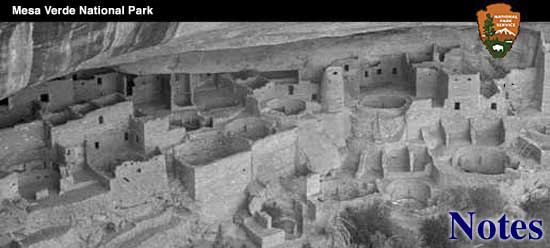

|
The average person visiting the Mesa Verde comes to see the Cliff Dwellings. In fact, to the general American public, Mesa Verde and such structures as Cliff Palace are synonymous. The Cliff Dwellings are indeed the most impressive and best known features of Mesa Verde National Park, but by no means do they constitute the sum of our prehistoric attractions. To most people the beauty and fascination of Cliff Palace is not merelying its size, in its architectural features, or in its tangible external appearance, but in the glamour and mystery of its past and of its inhabitants. The story of a lost race of humans who had bodies, minds, and emotions as we have today; who fought the bitter struggle of existence; who created a culture out of their environment—that is the heart and soul of an otherwise lifeless ruin. Scattered over the Mesa top are hundreds and thousands of remains of man's efforts; not as spectacular and massive as the Cliff Dwellings but surely as dramatic and stimulating. Countless mounds of sagebrush and sand are the coffin-covers of once vital, bustling homesites: surface pueblos similar to, but not as large as, Far View House, and smaller, cruder one and two room structures of horizontal masonry, heaped around their kivas. Not as noticeable are even earlier slab structures, or post-and-adobe houses, round or square, shallow or deep, betraying their hiding places by only a few scattered bits of pottery, or a bashful little mound or depression. Almost unknown to the early scientists and explorers of Mesa Verde as well as to its casual guests today, these surface ruins are a rich field awaiting the archaeologist's trowel. And they should be particularly valuable at this time because they belong to earlier cultures than that of the Cliff Dwellings; cultures making up the great transition stage and period of development between the late Basket Maker and the Classical Pueblos. Southwestern Archaeology, its accepted nomenclature, classifications and standards are undergoing at this very moment radical changes and upheavels. Discovery and research have fairly well established the eras of prehistory which we call Basket Maker I, Basket Maker II, and Pueblo III. But regularly every year and even every week the unwritten archaeological text books dealing with the periods now designated, for want of better knowledge, as Basket Maker III, Pueblo I, and Pueblo II must be revised. Expeditions now in the field in the Four Corners region of the Southwest are working on these problems. Noteworthy among them are Dr. Frank H. H. Roberts, from the Laboratory of Anthropology in Santa Fe, excavating pit houses near Houck, Arizona: L. L. Hargreave of the Museum of Northern Arizona, uncovering Pueblo II houses in the San Francisco Mountains: Earl Morris, who is preparing his publication on the pit-house sites on Red Mesa, just south of the Mesa Verde: J. O. Brew, of the Peabody Museum, working on pit, slab, and other early houses on Alkali Ridge, south of Monticello, Utah: Paul S. Martin, of the Field Museum of Chicago, at the Lowry Ruin near Ackmen, Colorado: Douglas Byers, also of Peabody Museum, finding intricate and valuable stratigraphy in Waterfall Ruin in the Chinlee Valley, Northwestern Arizona, and Dr. E. L. Hewitt, of the School of American Research, excavating Chettro Kettle in Chaco Canyon, New Mexico. The facts and findings of these authorities will soon be correlated and published and will lead Southwestern Archaeology from its present state of conflict and confusion. Here on the Mesa Verde we have just such house and pottery types as are being studied by the above mentioned archaeologists. Complex houses of relatively undeveloped coursed masonry, but with advanced pottery and kiva construction, represented by the larger mounds of the Mesa Verde, must be expertly excavated to discover their relationship to the Cliff Dwellings. There are isolated single and double room stone houses, characterized by less skilled ceramics, and by unconventionalized kivas that are but steps in the specialization of the pit house or house kiva into the well known ceremonial chamber. The niche of these ruins must be ascertained in the record of man's progress. Often, associated with the latter variety are jacal or post-and-adobe houses, which are either contemporaneous with or older than the crude sandstone block structures. Evidently preceding these, are large communities made up of small rectangular rooms built of adobe plaster on upright sandstone slabs set down in the earth. Along with this only recently recognized type of dwelling is found crude pottery of undecorated gray and a great deal of unusual red-on-buff ware. It is no exaggeration to say that every mesa top here on the Mesa Verde is practically covered with ruins. Beginning with the earliest cultures and running straight through to the Classical Period they constitute a definite story of human progress. Since the people who lived in these homes have long since disappeared it remains for the archaeologist to ferret out their story. | ||||||
| <<< Previous | > Cover < | Next >>> |
vol4-2f.htm
14-Oct-2011